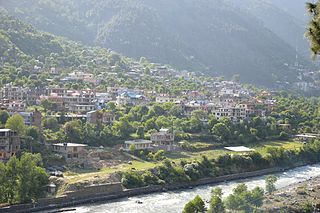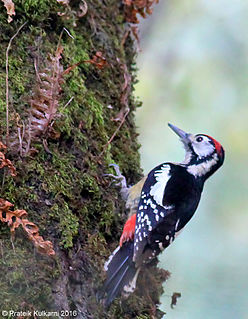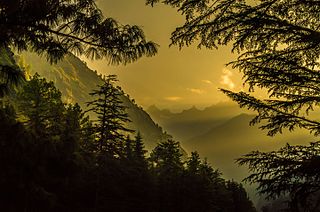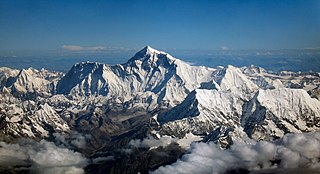
Kullu is a district in Himachal Pradesh, India. The district lies in central Himachal and is famous for its tourist stations and Himalayan Treks connecting the trails with far remote regions between the adjacent districts of Lahaul and Spiti, Kinnaur, Mandi and Kangra districts which are bordered at North - North East, East, West and South Of Kullu respectively. The District is also a home to some of the Ancient settlements, Traditional Handloom and Apple Cultivation. It stretches from the Town of Rampur in the south to the Rohtang Pass in the North. The Main Kullu Valley which falls between the Pir Panjal Himalayas and Northern Edge Of The Dhauladhar or Bhangal Region lies at an elevation ranging from as less as 833 M to 3330 M from Aut Tunnel North Portal to Rohtang Tunnel South Portal On NH 3 and NH 505.

Rohtang Pass . It is a high mountain pass on the eastern Pir Panjal Range of the Himalayas around 51 km (32 mi) from Manali. It connects the Kullu Valley with the Lahaul and Spiti Valleys of Himachal Pradesh, India.

Manali is a resort town nestled in the mountains of the Indian state of Himachal Pradesh near the northern end of the Kullu Valley in the Beas River Valley. It is located in the Kullu district, about 270 km (168 mi) north of the state capital, Shimla, 309 km north east of Chandigarh and 544 km northeast of Delhi, the national capital. The small town, with a population of 8,096, is the beginning of an ancient trade route to Ladakh and from there over the Karakoram Pass on to Yarkand and Khotan in the Tarim Basin. It is a popular tourist destination and serves as the gateway to Lahaul and Spiti district as well as Leh.

Parvati River is a river in the Parvati Valley in Himachal Pradesh, northern India that flows into the Beas River at Bhuntar, some 10 km south of Kullu. It rises from the Man Talai Glacier below the Pin Parbati pass and flows in a gradual curve from north-northwest to west-southwest past the important temple town of Manikaran.
Kullu or Kulu is the capital town of the Kullu district in the Indian state of Himachal Pradesh. It is located on the banks of the Beas River in the Kullu Valley about 10 kilometres (6.2 mi) north of the airport at Bhuntar.

The Great Himalayan National Park (GHNP), is one of India's national parks, is located in Kullu region in the state of Himachal Pradesh. The park was established in 1984 and is spread over an area of 1,171 km2 at an altitude of between 1500 and 6000 m. The Great Himalayan National Park is a habitat to numerous flora and more than 375 fauna species, including approximately 31 mammals, 181 birds, 3 reptiles, 9 amphibians, 11 annelids, 17 mollusks and 127 insects. They are protected under the strict guidelines of the Wildlife Protection Act of 1972; hence any sort of hunting is not permitted.

Situated on the left bank of river Beas at an altitude of 1,800 meters, Naggar is an ancient town in Kullu district of Himachal Pradesh, India. It was once capital of the Kullu kingdom.

Banjar is a town in Kullu district in the state of Himachal Pradesh, India. It is a part of Seraj region that extends from Jalori pass till Shikari Devi in Janjehli. The Tirthan valley is also a part of Banjar region with Banjar town being the main marketplace in Tirthan Valley. Tirthan river is major river of Banjar along with the tributary Pushpabhad flowing from Jalori pass through Jibhira. It is located at the confluence of these two rivers. Banjar is one the tehsil of Kullu district. 'Banjar mela ' is the prominent fair of Banjar valley. A dialect of Kullavi called Seraji is spoken here and the people are also called Serajis.
Sereolsar Lake is a high altitude lake in the outer Seraj Valley of the Kullu district, Himachal Pradesh, India. The lake is about 3,100 metres (10,171 ft) above the sea level and is surrounded by thick forest cover. Seruvalsar Lake is accessible via Jalori pass.
Forests in the state of Himachal Pradesh currently cover an area of nearly 37,691 square kilometres (14,553 sq mi), which is about 38.3% of the total land area of the state. The forests were once considered to be the main source of income of the state and most of the original forests were clear felled. The emphasis has shifted, however, from exploitation to conservation. The state government aims to increase forest cover to 50% of the total land area. There have been various projects, including the establishment of protected areas such as National Parks, designed to preserve and expand the forests.

Kullu Valley is a broad open valley in Himachal Pradesh, India, formed by the Beas River between Manali and Largi. This valley is famous for its temples, beauty and its majestic hills covered with pine and deodar forest and sprawling apple orchards. The course of the Beas river presents a succession of magnificent, clad with forests of deodar, towering above trees of pine on the lower rocky ridges. Kullu valley is sandwiched between the Pir Panjal, Lower Himalayan and Great Himalayan Ranges.. Ski touring is a sport growing in popularity in the Himilayan peaks surrounding the valley

The pink-browed rosefinch is a species of finch in the Fringillidae family. It ranges across the northern regions of the Indian subcontinent, mainly in the Himalayas, and is migratory. It is found in Bhutan, Tibet, India, Nepal, and Pakistan. Its natural habitats are boreal forests and subtropical or tropical dry forests.

The Himalayan woodpecker is a species of bird in the family Picidae. It is found in the northern regions of the Indian subcontinent, primarily the Himalayas and some adjoining areas, and ranges across Afghanistan, India, Nepal, Bhutan and Pakistan. Its natural habitats are boreal forests and temperate forests. The International Union for Conservation of Nature has assessed its conservation status as being of "least concern".

Kullu–Manali Airport is an airport located in Bhuntar in the Indian state of Himachal Pradesh. The airport is located 11 km from Kullu and 52 km from Manali.

Kasol is a hamlet in the district Kullu of the Indian state of Himachal Pradesh. It is situated in Parvati Valley, on the banks of the Parvati River, on the way between Bhuntar and Manikaran. It is located 30 km from Bhuntar and 3.5 km from Manikaran. Kasol is the Himalayan hotspot for backpackers. and acts as a base for nearby treks to Malana and Kheerganga. It is called Mini Israel of India due to a high percentage of Israeli tourists here.

Gopalpur Zoo is situated in Gopalpur village, Kangra district, Himachal Pradesh in India, en route the Dharmshala – Palampur road. It is surrounded by Dhauladhar Range of the Himalayas. The zoo is adorned with maple trees, horse chestnut trees, chil and greenery ..Zoo remains closed on every Monday. Timing 01 November to 31 March:- Tuesday to Sunday 09:00AM - 05:00PM. Timing 01 March to 31 August:- Tuesday to Sunday 08:00AM - 05:30PM.
Tourism in Himachal Pradesh relates to tourism in the Indian state of Himachal Pradesh. The is famous for its Himalayan landscapes and popular hill-stations. Many outdoor activities such as rock climbing, mountain biking, paragliding, ice-skating, trekking, rafting,and heli-skiing are popular tourist attractions in Himachal Pradesh.
A Kullu shawl is a type of shawl made in Kullu, India, featuring various geometrical patterns and bright colors. Originally, indigenous Kullvi people would weave plain shawls, but following the arrival of craftspeople from Bushahr in the early 1940s, the trend of more patterned shawls came to rise.














